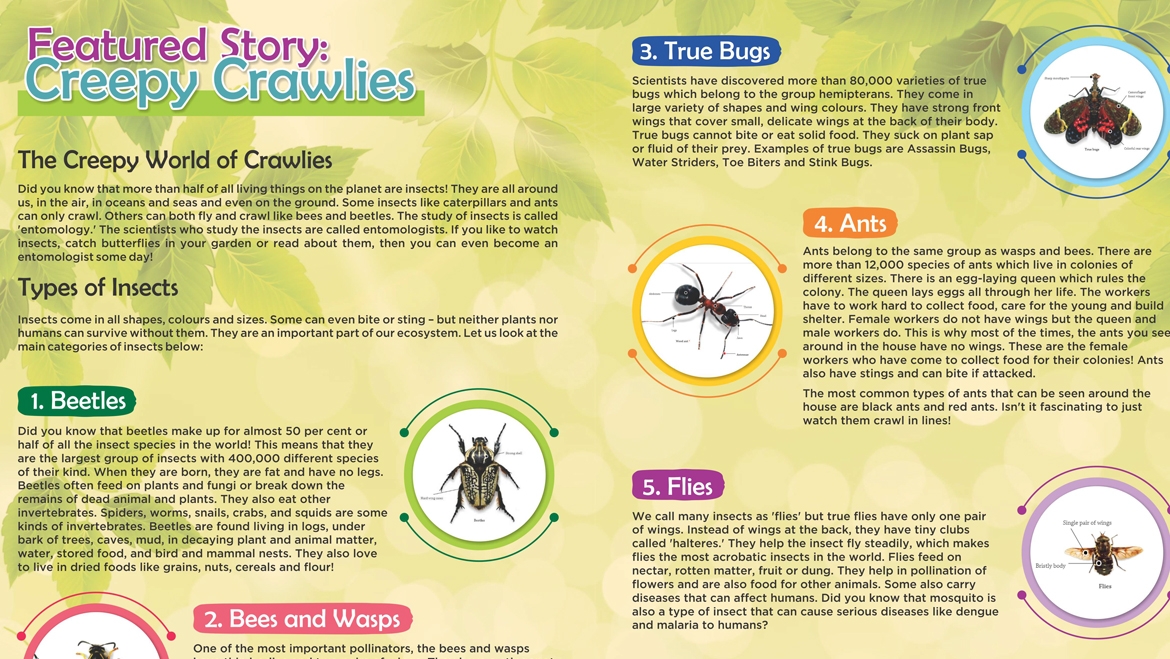THE CREEPY WORLD OF CRAWLIES
Did you know that more than half of all living things on the planet are insects! They are all around us, in the air, in oceans and seas and even on the ground. Some insects like caterpillars and ants can only crawl. Others can both fly and crawl like bees and beetles. The study of insects is called ‘entomology.’ The scientists who study the insects are called entomologists. If you like to watch insects, catch butterflies in your garden or read about them, then you can even become an entomologist some day!
Types of Insects
Insects come in all shapes, colours and sizes. Some can even bite or sting – but neither plants nor humans can survive without them. They are an important part of our ecosystem. Let us look at the main categories of insects below:
1. Beetles
Did you know that beetles make up for almost 50 per cent or half of all the insect species in the world! This means that they are the largest group of insects with 400,000 different species of their kind. When they are born, they are fat and have no legs. Beetles often feed on plants and fungi or break down the remains of dead animal and plants. They also eat other invertebrates. Spiders, worms, snails, crabs, and squids are some kinds of invertebrates. Beetles are found living in logs, under bark of trees, caves, mud, in decaying plant and animal matter, water, stored food, and bird and mammal nests. They also love to live in dried foods like grains, nuts, cereals and flour!
2. Bees and wasps
One of the most important pollinators, the bees and wasps have thin bodies and two pairs of wings. They have a stinger at the back of their bodies which is used to kill prey. If attacked, these insects can even sting the attacker! Some wasps and bees live in colonies or groups. The leader of the group is a single egg-laying queen. Honeybees, one of the most common type of bees, live in colonies or hive. Common wasps live in large groups. They have hairy heads which act as a sensor to give them information about their surroundings.
3. True bugs
Scientists have discovered more than 80,000 varieties of true bugs which belong to the group hemipterans. They come in large variety of shapes and wing colours. They have strong front wings that cover small, delicate wings at the back of their body. True bugs cannot bite or eat solid food. They suck on plant sap or fluid of their prey. Examples of true bugs are
4. Ants
Ants belong to the same group as wasps and bees. There are more than 12,000 species of ants which live in colonies of different sizes. There is an egg-laying queen which rules the colony. The queen lays eggs all through her life. The workers have to work hard to collect food, care for the young and build shelter. Female workers do not have wings but the queen and male workers do. This is why most of the times, the ants you see around in the house have no wings. These are the female workers who have come to collect food for their colonies! Ants also have stings and can bite if attacked.
The most common types of ants that can be seen around the house are black ants and red ants. Isn’t it fascinating to just watch them crawl in lines!
5. Flies
We call many insects as ‘flies’ but true flies have only one pair of wings. Instead of wings at the back, they have tiny clubs called ‘halteres.’ They help the insect fly steadily, which makes flies the most acrobatic insects in the world. Flies feed on nectar, rotten matter, fruit or dung. They help in pollination of flowers and are also food for other animals. Some also carry diseases that can affect humans. Did you know that mosquito is also a type of insect that can cause serious diseases like dengue and malaria to humans? You must have also seen the common housefly many a times in your home, garden and even garbage dumps.
6. Butterflies and moths
Who doesn’t love butterflies! Moths and butterflies are one of the most largest and colourful of all insects. Most commonly, they are small and brown in colour. All members of this group have two pairs of wings. These wings are covered in tiny scales which give colour to their wings. The adults feed on nectar. The young ones are at a crawling stage with no wings. We know them as caterpillars which grow up to become butterflies. Caterpillars feed on leaves. They change into a flying adult inside a cocoon called as chrysalis. The difference between a butterfly and a moth is that the former flies in the day, with its wings closed. The latter usually flies at night with its wings open.
7. Crickets, locusts and grasshoppers
These insects belong to a group called Orthoptera. Together, they make up more than 20,000 species. They have long, powerful hind legs for jumping. Hence, instead of flying away, they jump away from danger which makes it difficult to catch them. Interestingly, cricket and grasshoppers communicate using a chirping noise called a song.
Locusts are grasshoppers that live in swarms as it is easier to find food living in a group. They can cause great damage to crops. They can also change colour from green to brown when they are overcrowded.
8. Dragonflies and damselflies
With their transparent wings, dragonflies and damselflies chase other insects for food. They have bright striking coloured bodies and amazing flying skills. However, they mostly spend their lives as water-dwelling larvae. This way, they stay hidden in the depths of rivers and lakes.
One of the most ancient species of this group is the Mayfly. It can take as long as three hours for a Mayfly in water to grow as an adult. However, once they have matured into adults, they may live for just a few hours. They do all their eating when they young. The adult Mayflies do not eat at all.
Quiz Time
It’s quizzing time! Match the right collective known for each group of insects you have studied above. Here’s an example. For example, a group of bees, or many bees is called as a ‘swarm of bees.’ So you match bees with the word ‘swarm.’ Let’s see how many you can get right.
| Insect name | Collective noun |
| Ants | Army |
| Bees | Cluster |
| Caterpillars | Plague |
| Grasshoppers | Colony |
| Locusts | Hive, swarm |
| Flies | Kaleidoscope, flutter |
| Butterflies | Swarm, Business |
| Mosquitoes | Nest |
| Wasps | Scourge |

